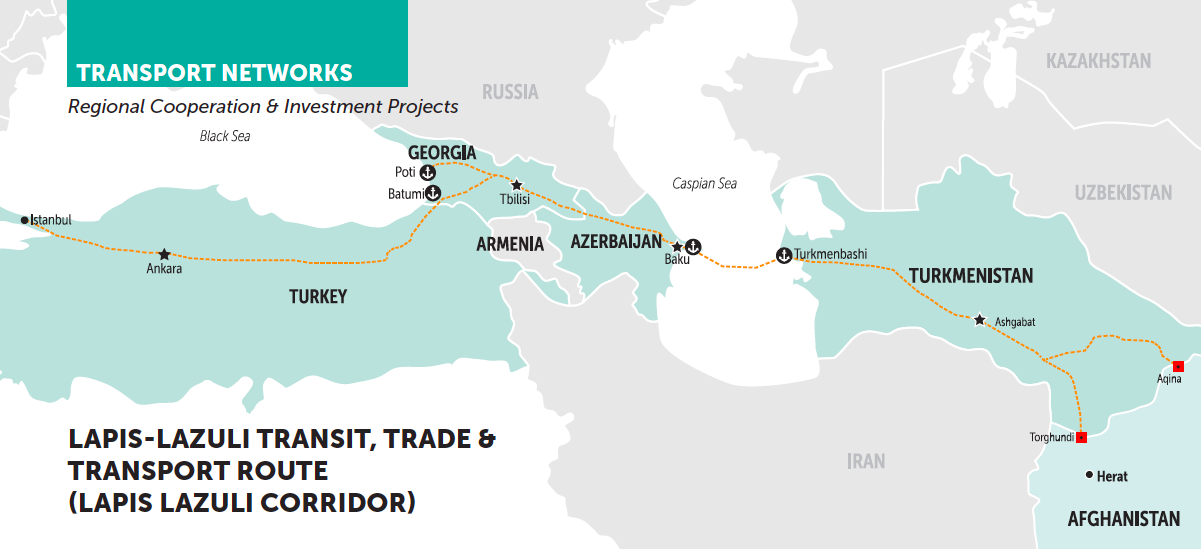Azerbaijan's role in shaping Lapis Lazuli corridor: Reviving ancient trade links

Today, nations across the Caspian region, along with Europe, Turkiye, Central Asia, and China, are eager to collaborate with Azerbaijan in the transport and logistics sector, recognizing the country's pivotal role as a regional transport hub.
The country stands at the crossroads of several key initiatives of the Great Silk Road, including the EU's Europe-Caucasus-Asia (TRACECA) route, China's Belt and Road Initiative, the Trans-Caspian International Transport Route (TITR), and the Lapis Lazuli project in collaboration with Turkmenistan, Afghanistan, and Turkiye. Most certainly, in recent geopolitical shifts in Eurasia, there has been a growing demand for railway trans-shipment through Azerbaijan. The latter frequently incorporates trans-shipment via the Middle-Corridor. As a result, the partner countries are proactively collaborating on a range of initiatives aimed at enhancing transit traffic along the Middle Corridor.
Afghanistan's Quest for New Trade Routes
As one of the landlocked countries, Afghanistan is continually trying to find new routes to solve trade and transit problems to reach open waters. Despite trade and transit agreements between Afghanistan and Pakistan, security problems along the country's Chabahar port route and delays in its operation as an international port to access India's major markets, in addition to long distance and high transport costs on the road to Iran's Bandar Abbas make Afghanistan looking for alternatives to export its products to the European market. For this mentioned purpose, the Lapis Lazuli Route Transport and Transit Agreement was initiated by then Afghan foreign minister and economic cooperation minister, Wahidullah Waissi. The agreement aims to enhance regional economic cooperation and connectivity between the countries of Afghanistan, Turkmenistan, Azerbaijan, Georgia, and Turkiye, thereby expanding economic and cultural links between Europe and Asia. In doing so, the initiative seeks to improve transport infrastructure and procedures (including for road, rail, and sea), increase exports, and expand the economic opportunities of citizens in countries benefiting from this new transport corridor. The "Lapis Lazuli" corridor presents the most optimal route for international access, given the current situation in Afghanistan.
The Lapis Lazuli Corridor: Geopolitical Implications and the Need for Investment
The name of the transport corridor comes from the color of the mineral lapis lazuli, which was one of the main items of exports from Central Asia to the Middle East, Europe, and North Africa in ancient times. Negotiations over the establishment of this new corridor date back to 2012 and continued for five years due to several factors in the region, including insecurity (growing domestic violence), economic instability across Central Asia, and a legacy of poorly developed infrastructure networks in the member countries involved. Once the infrastructure in Azerbaijan, including the Baku-Tbilisi-Kars International Trade Port, is complete, cargo from Kazakhstan, China, and other places can pass through Azerbaijan. This corridor can also be considered the fastest method and means of delivery of products from China to the Eurasian market. So, the product will be delivered to London in a maximum of 12 days. Thus, the cargo transportation process in the Lazurite corridor will be carried out by rail, sea, road, and air. An important part of this concept is that if the Zangezur corridor is opened, then the route can also pass through the territory of Armenia. A direct connection of communications between Turkiye and Azerbaijan is also in perspective. As a result, the Lapis Lazuli and Zangezur corridors gain the opportunity to integrate into the "North-South" and "New Silk Road" international transport corridors.
In light of this, there is no reason why cargo from Afghanistan should not also be transported through Azerbaijan. Moreover, the individual countries participating in the development of the Lapis Lazuli Corridor have their own interests at stake. Turkmenistan hopes to diversify its economy, Afghanistan seeks an alternative trade route and Azerbaijan aims to enhance regional connectivity. Given this fact, the route’s potential extension to include Pakistan and India would offer critical economic benefits and enhanced access to the Indian Ocean. Nevertheless, further consultations with international partners and donors as well as increased investments are needed to realize the project’s full potential. Ultimately, with the improvement of infrastructure and regional connectivity, this transit project will likely enhance economic and political stability among the countries involved as well as in the regions where they operate.
---
Follow us on Twitter @AzerNewsAz
Here we are to serve you with news right now. It does not cost much, but worth your attention.
Choose to support open, independent, quality journalism and subscribe on a monthly basis.
By subscribing to our online newspaper, you can have full digital access to all news, analysis, and much more.
You can also follow AzerNEWS on Twitter @AzerNewsAz or Facebook @AzerNewsNewspaper
Thank you!

